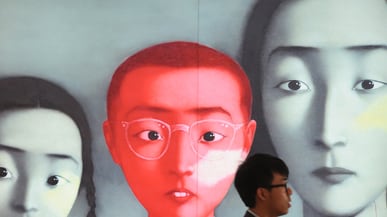New York’s Asian Art Week was spectacular. A delicate pear-shaped Chinese vase was the star of the week, skyrocketing past its pre-sale estimate of $800 to $1,200 to sell for more than $18 million. A carved celadon-glazed ceramic Qianlong vase sold for $7.9 million, double its high presale estimate. Combined, Sotheby’s and Christie’s International took in a record $202 million during the week, 56 percent above the prior 2007 peak.

The electricity transferred over to Europe, where a Beijing collector paid a record $31 million for a Chinese scroll on March 26 at an auction in Toulouse, France. And this week has been equally exciting. Global art collectors descended upon the Hong Kong Convention and Exhibition Centre for Sotheby’s 3,600 lot series of auctions. A painting by Zhang Xiaogang set a new record, selling for more than double pre-auction estimates. The most anticipated auction was Thursday evening’s sale of the Meiyintang collection of imperial Chinese porcelain.
Thursday evening’s auction disappointed. Despite telegraphing an expected auction sales range of between HK$700 million and HK$1 billion ($90 million and $128 million) (with rumors suggesting a significantly higher sales price was probable), Sotheby’s posted auction sales of less than HK$400 million for the collection. Might this be an early warning sign of an art bubble about to burst? What are the implications of an art market slowdown?
From most accounts, China appears to be the most important driver of the art market today…and not just as a source of desired art. Wealthy Chinese buyers are the largest source of incremental demand, with Chinese billionaire buyers as the most confident. Art dealer Andrew Kahane, who specializes in Chinese art, summarized the buying desires: “Chinese buyers want to be seen spending a lot of money. They want to be seen setting world records.”
These developments certainly point to a rising sense of confidence, perhaps even overconfidence, among the Chinese. Might the ups and downs of the art business be a reflection of surging and waning confidence? Is it possible that recent world record art prices are an indication of unsustainable economic conditions? Could China be in the midst of an unsustainable asset bubble?
The recent auction records are not as anomalous as they may appear. Chinese influence on art markets has risen steadily over the past year. In May 2010, the art world was energized by a Chinese buyer paying a world record $106.4 million for a work by Pablo Picasso. Last November, an 18th-century vase from the Qianlong period, which had been found in a dusty old attic, was purchased at auction for $86 million (presale estimates had ranged from $1.3 million to $2 million) by a buyer from mainland China. It was the highest price ever paid at auction for a Chinese antiquity.
Overconfidence and hubris, manifested in world record art prices, should be as disturbing to policymakers and investors as it is exciting to Sotheby’s and Christie’s.
Traditional buyers have noted this newfound buying pressure, finding it frustrating when seeking to purchase art. Morgan Long, head of art services at The Fine Art Fund, noted that funds “have come across frantic bidding from people from the Chinese mainland. We haven’t been able to buy anything we wanted at the prices we were looking for.”
One of the largest asset bubbles ever formed was in Japan during the late 1980s. The bursting of the “Bubble Economy,” as it has since been known, might have seemed, even at the time, almost inevitable when examined through the lens of art markets. Consider the parallels.
In the then-highest price ever paid for a painting, van Gogh’s Still Life: Vase with Fifteen Sunflowers sold in 1987 to a Japanese buyer for almost $40 million, approximately four times the previous record for a painting.
The Japanese art craze possibly peaked (along with its asset markets) when Ryoei Saito, chairman of Daishowa Paper Manufacturing, paid $82.5 million for van Gogh’s Portrait of Dr. Gachet and over $78 million for Renoir’s Le Moulin de la Galette in May 1990. He then proceeded to shock the art world and the sensibilities of collectors worldwide by stating he would cremate the paintings with his body upon his death.
The similarities with Japan suggest that the enormous Chinese influence on the art market is an indicator of a forthcoming bust in China. It reflects a national overconfidence that has been a consistent ingredient in financial bubbles. Prudent investors would take great pride in selling at world record prices. Wanting to buy at world record prices is a spectacular reflection of hubris in action.
The disappointing results from Thursday’s Meiyintang auction might indicate that expectations of continually rising prices are now ahead of themselves, and that overconfidence and hubris are running out of steam. Was this auction revealing the first cracks in what has otherwise been a very positive story? Is this a sign of an imminent bust?
Seductive rationalizations about China’s enormous population, its tremendous wealth generation, or its industrious labor force are hard to transcend. Policymakers, investors, and corporate boardrooms, however, must attempt to do so because the ramifications of a China bust are so large. For example, China’s influence on the commodity markets has been domineering. If China’s appetite for materials were to slow materially, then many commodities would be over-supplied and prices would fall. Commodity markets have at least partially been supporting the emerging markets growth story, and without that story, the world will likely grow at a significantly slower rate.
Despite the allure of seductive rationalizations, healthy skepticism combined with a careful monitoring of the art market can help one realize that it’s unlikely to be different this time. Overconfidence and hubris, manifested in world record art prices, should be as disturbing to policymakers and investors as it is exciting to Sotheby’s and Christie’s, for in today’s increasingly interconnected world, even the slightest disturbance can ripple from China to Iowa.
Vikram Mansharamani is a lecturer at Yale University where he teaches a popular seminar called "Financial Booms and Busts." His new book is Boombustology: Spotting Financial Bubbles Before They Burst.






